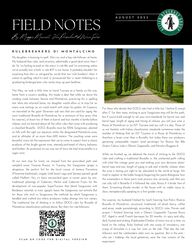
Return to flip book view
FIELD NOTESMy daughter is learning to spell. She’s six, and a big rule-follower at home.My husband likes rules, and structure, admittedly a good deal more than Ido. So “no fooling around on the stairs” is rule #6, and “no screaming unlesswe’ve actually lost a limb” is rule #37 in our house. It probably shouldn’t besurprising that she’s so intrigued by words that are “rule breakers” when itcomes to spelling: silent h’s and “a” pronounced like “u” seem titillating to agraduating kindergartener who rarely stays up past bedtime.This May, we took a little time to travel Tuscany as a family on the wayhome from a cousin’s wedding. We made a deal that while we drove thewinding roads between Sienna and Montalcino, practicing for a spellingtest when she returned home, my daughter would allow us to stop for asmany wine tastings as we could match with stops for gelato. At Caparzo,we marveled at the giant Slovenian oak vats that are used for aging themost traditional Brunello di Montalcino for a minimum of four years (fivefor reserve), at least two of them in barrel and four months in bottle beforerelease, and we learned about all the other rules that come with producinga classified Brunello. DOCG Brunello must be 100% Sangiovese, plantedon hills with the right sun exposure within the designated Montalcino area,and at altitudes of no more than 600 meters. The resulting wines werebeautiful: every bit the expression that we’ve come to expect from a classicproducer of this bright garnet wine, intensely perfumed of cherry, balsamicand leather. As promised, on our way out of town she had stracciatella in asugar cone.At our next stop for lunch, we strayed from the prescribed path andsampled some Toscana Rossos. In Tuscany, the Sangiovese grape isubiquitous: the perfect foil for the local cuisine of bisteca Fiorentina(Florentine beefsteak), cingale (wild boar) ragu and Sienese spinach gnudicalled Malfatti. Yes, it’s been encroached upon in recent years by non-traditional plantings of Cabernet, Merlot and Cabernet Franc for thedevelopment of now-popular SuperTuscans that blend Sangiovese withBordeaux varietals or even (gasp!) leave the Sangiovese out entirely. Butfor those who stick to Sangiovese, the methods by which Sangiovese ishandled and crafted are where producers today diverge into two camps.The traditional line of thinking is to follow DOCG rules for Brunello diMontalcino classification outlined above. But that’s for rule-followers.By: Maggie Maxwell, Vice President of Wine SalesFor those who decide that DOCG rules feel a little too “I before E exceptafter C” for their taste, sticking to pure Sangiovese may still be the path,but if you’re bold enough to set your own standards for barrel size andbarrel type, length of aging and timing of release, you call your wine aRosso di Montalcino or an IGT Toscana and you call it a day. Those ofus not familiar with Italian classification standards sometimes make themistake of thinking that an IGT Toscana or a Rosso di Montalcino istherefore a lesser wine than a Brunello, but today there are producersgarnering comparable respect (and pricetags) for Rossos like BibiGraetz Colore, Isole e Olena's Cepparello, and Petrolo’s Boggina A. While we finished up, we debated the merits of sticking to the DOCGrules and crafting a traditional Brunello vs. the uncharted path: rollingwith what the vintage gives you and making your own decisions aboutbarrel type and size, length of aging in oak and in bottle, release whenthe wine is tasting just right to be unleashed to the world at large. Wetried to explain to the kiddo hungrily bogarting her pasta Bolognese howthe winemakers in those parts took process very seriously, and that youcan only call it Brunello if it followed the rules, Rosso if it broke free ofthem. Screaming bloody murder in the house with no viable injury toshow, metaphorically speaking to a first grader rising. No surprise, my husband finished his lunch favoring San Polo’s RiservaBrunello di Montalcino: structured, traditional, all dried cherry, coffeeand anise, made painstakingly according to DOCG rules. Proven andproper. I finished favoring Isole e Olena’s Cepparello Toscana RossoIGT. Aged in small French barriques for 20 months, it’s spicy and silky,dark fruited and striking. Rulebreaker.Climber of stairs two at a time, nohand on the railing. Ruby finished with one scoop of strawberry, onescoop of chocolate in a cup, her cone on the side. That day the rulefollowers and the rulebreakers alike won, no question. But in the end---who am I kidding---the local gelaterias were the true winners of theexperiment.R U L E B R E A K E R S D I M O N T A L C I N OA U G U S T 2 0 2 3S C A N Q R C O D E F O R D I G I T A L V E R S I O N